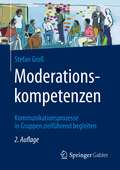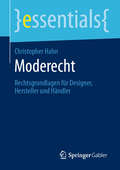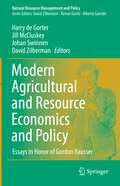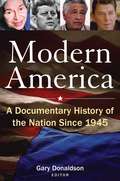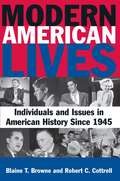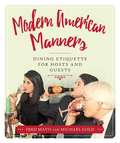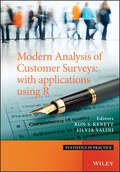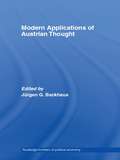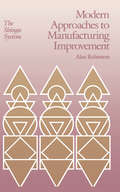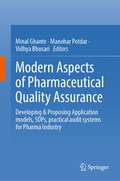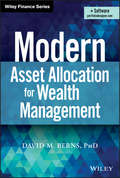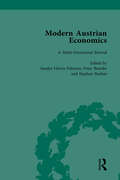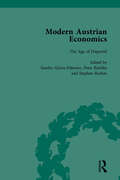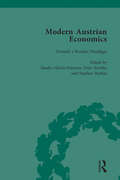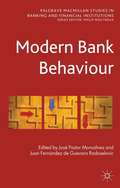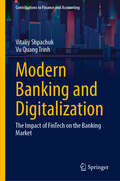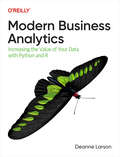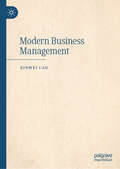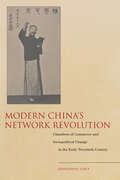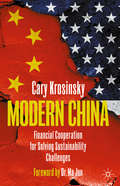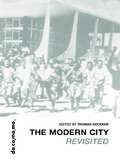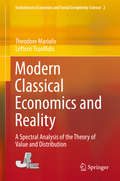- Table View
- List View
Moderationskompetenzen: Kommunikationsprozesse in Gruppen zielführend begleiten
by Stefan GroßDieses Buch vermittelt kompakt und fundiert Moderationskompetenz für alle, die Besprechungen, Meetings, Workshops oder Projektrunden erfolgreich leiten wollen. Wo dies gelingt, werden Kommunikationsprozesse in Gruppen zu zielorientierten, effektiven und effizienten Ergebnissen führen – ob virtuell oder in Präsenz.Der Autor zeigt systematisch auf, wie der Informationsaustausch in solchen Gesprächsrunden klug vorgedacht, dynamisch begleitet und wirkungsvoll gesteuert werden kann. Mit zielführenden Fragen, methodischen Impulsen und unterschiedlichen Formaten der Beteiligung gelingt es so, gemeinsam in der Gruppe Probleme zu lösen, Konflikte zu klären, nachhaltige Ideen zu entwickeln und gute Entscheidungen zu treffen.Am Ende solcher Veranstaltungen steht ein Mehrwert für alle: zufriedene Teilnehmer, tragfähige Resultate und eine kooperative Besprechungskultur, die die Grundlage für einen dauerhaften Unternehmenserfolg bilden.„Trotz der Vielzahl von Büchern über das Thema eine Bereicherung.“ Dr. Joachim Freimuth, ZOE, 01/2019.„Dieses Praxisbuch bietet eine zeitgemäße Handreichung für die zahlreichen Herausforderungen, der sich eine dynamische Moderation stellen muss.“ Prof. Kai Beiderwellen, Hochschule Mannheim„Das Buch ist eine Einladung zur vertieften und reflexiven Entwicklung der eigenen Rolle.“ Dr. Wolfgang Widulle, Socialnet.deNeu in der zweiten Auflage: Die Kapitel zu virtueller Moderation, zum gemeinsamen Lernen und praxiserprobte Strukturhilfen, Vorlagen, Checklisten und Projektskizzen als Download.
Moderecht: Rechtsgrundlagen für Designer, Hersteller und Händler (essentials)
by Christopher HahnChristopher Hahn vermittelt einen Einblick in die Grundzüge des Moderechts. Die Kreation von Modekollektionen ist ein zeitaufwendiger und kostspieliger Prozess für Designer und Produzenten. Alle Akteure der Modeindustrie sehen sich im Rahmen ihrer Geschäftstätigkeit mit Rechtsfragen aus unterschiedlichen Gebieten konfrontiert. Der bestmögliche und nachhaltige Schutz von Modeerzeugnissen ist nur ein wichtiges Element für den langfristigen Erfolg. Neben den grundsätzlichen rechtlichen Fragestellungen zur Herstellung und zum Vertrieb von Modeerzeugnissen werden in diesem essential die rechtlichen Querschnittsmaterien mit Bezug zu Modeprodukten dargestellt. Der Autor erläutert die rechtlichen Besonderheiten des marken- und designrechtlichen Gestaltungsschutzes ebenso wie Fragen der rechtlichen Ausgestaltung von Kooperationen mit den Akteuren der kreativen Wertschöpfungskette (Designer, Models, Influencer).Der Autor:Dr. Christopher Hahn ist als Wirtschaftsanwalt in Berlin und München vor allem im Bereich Unternehmensrecht aktiv. Zu seinen Mandanten gehören neben Designern auch namhafte Unternehmen der Modeindustrie. Daneben ist er selbst als Business Angel an Modeunternehmen beteiligt.
Modern Advertising and the Market for Audience Attention: The US Advertising Industry's Turn-of-the-Twentieth-Century Transition (Routledge Explorations in Economic History)
by Zoe ShermanModern advertising was created in the US between 1870 and 1920 when advertisers and the increasingly specialized advertising industry that served them crafted means of reliable access to and knowledge of audiences. This highly original and accessible book re-centers the story of the invention of modern advertising on the question of how access to audiences was streamlined and standardized. Drawing from late-nineteenth and early-twentieth-century materials, especially from the advertising industry’s professional journals and the business press, chapters on the development of print media, billboard, and direct mail advertising illustrate the struggles amongst advertisers, intermediaries, audience-sellers, and often-resistant audiences themselves. Over time, the maturing advertising industry transformed the haphazard business of getting advertisements before the eyes of the public into a market in which audience attention could be traded as a commodity. This book applies economic theory with historical narrative to explain market participants’ ongoing quests to expand the reach of the market and to increase the efficiency of attention harvesting operations. It will be of interest to scholars of contemporary American advertising, the history of advertising more generally, and also of economic history and theory.
Modern Agricultural and Resource Economics and Policy: Essays in Honor of Gordon Rausser (Natural Resource Management and Policy #55)
by Johan Swinnen David Zilberman Harry De Gorter Jill McCluskeyThis volume celebrates the life and career of Gordon Rausser, pioneer and leader in natural resource economics, while critically overviewing the emerging literature in the field. As the chair of the Agriculture and Resource Economics department at UC Berkeley, Rausser led the transformation of the department from a traditional agricultural economics department to a diverse resource economics department addressing issues of agriculture, food, natural resources, environmental economics, energy, and development. This book builds on this theme, showcasing not only the scope of Rausser's work but also key developments in the field. The volume is organized into two parts. The first part speaks about the lessons of Gordon Rausser's career, in particular, his role as a leader in different spheres, his capacity to integrate teaching and entrepreneurship, and his impact on the world food system. The second part will address some of the significant developments in the field he contributed to and how it relates to his work. The chapters include contributions from modern leaders in the economics field and cover diverse topics from many subfields including public policy, public finance, law, econometrics, macroeconomics, and water resources. Providing an excellent reference, as well as a celebration of a pivotal figure in the field, this volume will be useful for practitioners and scholars in agricultural and resource economics, especially the many individuals familiar with Gordon Rausser and his career.
Modern America: A Documentary History of the Nation Since 1945 (G - Reference, Information And Interdisciplinary Subjects Ser.)
by Robert H DonaldsonThis primary source reader assembles key documents and firsthand accounts that are emblematic of American life from the end of World War II to the present. Designed to complement a core text for a typical post-1945 U.S. history course, the book offers conciseness and selectivity with balanced coverage of domestic and foreign, societal and cultural issues grouped together chronologically. The readings afford students compelling and sometimes startling insights into the nation's postwar adaptation to its new position of global power and responsibility, wealth, and rapid social change; on through years of energy and ambition, conflict and tragedy, to the post-Vietnam malaise and the rise of Ronald Reagan, the frenzied nineties, and the arrival of the new millennium. Each chapter includes an introduction that sets the documents in historical context, a biographical sketch of a significant person of the time, study questions, and suggestions for further reading.
Modern American Lives: Individuals and Issues in American History Since 1945
by Robert C. Cottrell Blaine T BrowneThe individuals presented in these narrative biographies significantly, and sometimes decisively, impacted contemporary American life in a wide range of areas, including national politics, foreign policy, social and political activism, popular and literary culture, sports, and business. The combined biographical/thematic approach is designed to serve two purposes: to present more substantive biographical information, and to offer a fuller examination of key events and issues. The book is an ideal supplement for undergraduate courses on The United States Since 1945, as well as for courses on Modern America and 20th Century America.
Modern American Manners: Dining Etiquette for Hosts and Guests
by Fred Mayo Michael GoldThis practical and humorous guide helps readers learn appropriate manners so they can enjoy the pleasures of good food, good drink, and good company without worrying about what behavior is proper. Chapters cover how to be a good host, how to be a good guest, and how to behave at business events, cocktail parties, formal dinners, and restaurants. There is also a unique chapter discussing pet peeves and how to handle them with grace, civility, and appropriate manners. What’s the proper way to hold a wine glass? What’s an appropriate gift to bring a host and what shouldn’t you bring? How should you correctly introduce guests to each other? If you’re the host, how do you determine who should sit next to whom? What should you do if you don’t want to drink alcohol at a cocktail party? What is appropriate cell phone usage at a business dinner? Here are easy-to-implement answers to these and many other important etiquette questions. Lavishly illustrated with memorable full-color photographs that highlight both good and bad table manners, Modern American Manners is full of friendly advice for business professionals, college students entering the workplace, and anyone needing a refresher course or an introduction to proper behavior.
Modern Analysis of Customer Surveys
by Ron Kenett Silvia SaliniCustomer survey studies deals with customers, consumers and user satisfaction from a product or service. In practice, many of the customer surveys conducted by business and industry are analyzed in a very simple way, without using models or statistical methods. Typical reports include descriptive statistics and basic graphical displays. As demonstrated in this book, integrating such basic analysis with more advanced tools, provides insights on non-obvious patterns and important relationships between the survey variables. This knowledge can significantly affect the conclusions derived from a survey.Key features:Provides an integrated, case-studies based approach to analysing customer survey data.Presents a general introduction to customer surveys, within an organization's business cycle.Contains classical techniques with modern and non standard tools.Focuses on probabilistic techniques from the area of statistics/data analysis and covers all major recent developments.Accompanied by a supporting website containing datasets and R scripts.Customer survey specialists, quality managers and market researchers will benefit from this book as well as specialists in marketing, data mining and business intelligence fields.
Modern Applications of Austrian Thought (Routledge Frontiers of Political Economy)
by Jürgen G. BackhausAustrian economics is often criticized as being hostile to empirical research and seen purely as an ideology. In contrast, the purpose of this book is to show that Austrian economics provides an interesting approach to most conceivable subjects in economics. Edited by Jürgen G. Backhaus, this comprehensive volume includes Austrian analysis of: health economics labour economics taxation business cycle theory property rights. Contributors include Roger Koppl, Bart Nooteboom, Larry Moss, Dick Wagner and Gerrit Meijer, and this significant book will prove invaluable to students of economics and will make interesting reading for applied economists in any area of application.
Modern Approaches to Manufacturing Improvement: The Shingo System
by Alan RobinsonHere's the quickest and most inexpensive way to learn about the pioneering work of Shigeo Shingo, co-creator (with Taiichi Ohno) of just-in-time. It's an introductory book containing excerpts of five of his classic books as well as an excellent introduction by Professor Robinson.
Modern Aspects of Pharmaceutical Quality Assurance: Developing & Proposing Application models, SOPs, practical audit systems for Pharma Industry
by Minal Ghante Manohar Potdar Vidhya BhusariThe pharmaceutical quality system ensures that the process performance is suitably achieved, the product quality is regularly met, improved opportunities are identified and evaluated, and the knowledge is constantly expanded. Auditing also plays a crucial role within the pharmaceutical industry. It helps to assess and review quality to improve and build a better system for the benefit of companies. This book aims to develop a tool that will substantially decrease the number of Inspectional Observations and Warning letters, thus eliminating Import Alerts and Consent Decree. This book targets the Pharmaceutical Industry and students of Pharmaceutical Quality Assurance so they can get in hand-ready consolidated information on Pharmaceutical Quality guidelines, Quality metrics, and implementation of simplified SOP guidelines, plant layouts to implement Quality metrics for Pharmaceutical Manufacturing systems in tablets, capsules, liquid orals, and semi-solid dosage forms. The chapters cover the various aspects of Pharmaceutical Quality Assurance. The selection of topics is mainly based on the requirements of Pharmaceutical regulatory guidelines of India, the UK, the USA, Australia, and South Africa. Each chapter includes the abstract, detailed explanation, implementation guidelines, flowcharts, layouts, and Standard Operating Procedure of quality metrics for the Pharmaceutical Manufacturing System
Modern Asset Allocation for Wealth Management (Wiley Finance)
by David M. BernsAn authoritative resource for the wealth management industry that bridges the gap between modern perspectives on asset allocation and practical implementation An advanced yet practical dive into the world of asset allocation, Modern Asset Allocation for Wealth Management provides the knowledge financial advisors and their robo-advisor counterparts need to reclaim ownership of the asset allocation component of their fiduciary responsibility. Wealth management practitioners are commonly taught the traditional mean-variance approach in CFA and similar curricula, a method with increasingly limited applicability given the evolution of investment products and our understanding of real-world client preferences. Additionally, financial advisors and researchers typically receive little to no training on how to implement a robust asset allocation framework, a conceptually simple yet practically very challenging task. This timely book offers professional wealth managers and researchers an up-to-date and implementable toolset for managing client portfolios. The information presented in this book far exceeds the basic models and heuristics most commonly used today, presenting advances in asset allocation that have been isolated to academic and institutional portfolio management settings until now, while simultaneously providing a clear framework that advisors can immediately deploy. This rigorous manuscript covers all aspects of creating client portfolios: setting client risk preferences, deciding which assets to include in the portfolio mix, forecasting future asset performance, and running an optimization to set a final allocation. An important resource for all wealth management fiduciaries, this book enables readers to: Implement a rigorous yet streamlined asset allocation framework that they can stand behind with conviction Deploy both neo-classical and behavioral elements of client preferences to more accurately establish a client risk profile Incorporate client financial goals into the asset allocation process systematically and precisely with a simple balance sheet model Create a systematic framework for justifying which assets should be included in client portfolios Build capital market assumptions from historical data via a statistically sound and intuitive process Run optimization methods that respect complex client preferences and real-world asset characteristics Modern Asset Allocation for Wealth Management is ideal for practicing financial advisors and researchers in both traditional and robo-advisor settings, as well as advanced undergraduate and graduate courses on asset allocation.
Modern Austrian Economics Vol 1
by Sandye Gloria-Palermo Peter J Boettke Stephan BohmExamines the post-1970s area of the Austrian economic tradition, from its revival to its contemporary directions and development. The book comprises texts on the relationship of Austrian economics to Institutionalism, Evolution, and Post-Keynesian economics to present a look at "the way forward".
Modern Austrian Economics Vol 2
by Sandye Gloria-Palermo Peter J Boettke Stephan BohmExamines the post-1970s area of the Austrian economic tradition, from its revival to its contemporary directions and development. The book comprises texts on the relationship of Austrian economics to Institutionalism, Evolution, and Post-Keynesian economics to present a look at "the way forward".
Modern Austrian Economics Vol 3
by Sandye Gloria-Palermo Peter J Boettke Stephan BohmExamines the post-1970s area of the Austrian economic tradition, from its revival to its contemporary directions and development. The book comprises texts on the relationship of Austrian economics to Institutionalism, Evolution, and Post-Keynesian economics to present a look at "the way forward".
Modern Automation (A): Artificial Intelligence
by William R. Kerr James PalanoThis primer provides an overview of the implications of automation technology based on state-of-the-art "Artificial Intelligence" (AI) in the late 2010s: including the trends leading to the surge in AI, applications of AI categorized by the type of work performed, limitations of the technology, discussion about AI adoption, and key concerns the technology brought about.
Modern Automation (B): Robotics
by William R. Kerr James PalanoDriven largely by advances in perception and situational awareness, robots in the 2010s were gaining functionality that allowed them to be applied to fundamentally new types of work. The expanding range of new types of tasks that could be completed by machines had significant implications for businesses, the workforce, and society. This primer grounds conversations about these implications by illustrating real-world examples of the new types of activities that robots were becoming able to perform. It describes the functionality limitations which dictated how earlier robots could be deployed and the advances in underpinning technology which have moved these boundaries and led to the current inflection point.
Modern Bank Behaviour (Palgrave Macmillan Studies in Banking and Financial Institutions)
by Juan Fernández de Guevara Radoselovics José Manuel Pastor MonsálvezUpdated insight into key facts impacting on financial institutions after the financial crisis, highlighting areas of major policy and academic interest. The book includes ten chapters analysing contrasting issues such as intellectual capital, cost efficiency, bank stability, credit risk and business models for the wealth management industry.
Modern Banking and Digitalization: The Impact of FinTech on the Banking Market (Contributions to Finance and Accounting)
by Vu Quang Trinh Vitaliy ShpachukThis book provides a comprehensive overview of the evolving dynamics in modern banking, emphasizing how digitalization and optimization are reshaping operational frameworks, fundamentally altering institutional structures, and introducing new risks and opportunities. These transformative changes are anticipated to significantly impact the competitive landscape of the financial market. By exploring the primary trends and characteristics shaping the future of banking activities and institutions, this book offers crucial insights for bank owners and founders as they formulate strategic guidelines for their operations, as well as for bank managers in their current activities.
Modern Business Analytics: Increasing the Value of Your Data with Python and R
by Deanne LarsonDeriving business value from analytics is a challenging process. Turning data into information requires a business analyst who is adept at multiple technologies including databases, programming tools, and commercial analytics tools. This practical guide shows programmers who understand analysis concepts how to build the skills necessary to achieve business value.Author Deanne Larson, data science practitioner and academic, helps you bridge the technical and business worlds to meet these requirements. You'll focus on developing these skills with R and Python using real-world examples. You'll also learn how to leverage methodologies for successful delivery. Learning methodology combined with open source tools is key to delivering successful business analytics and value.This book shows you how to:Apply business analytics methodologies to achieve successful resultsCleanse and transform data using R and PythonUse R and Python to complete exploratory data analysisCreate predictive models to solve business problems in R and PythonUse Python, R, and business analytics tools to handle large volumes of dataCommit code to GitHub to collaborate with data engineers and data scientistsMeasure success in business analytics
Modern Business Management
by Xinwei CaoThis book explores the evolving dynamics of market competition in an age defined by rapid technological advancements and globalization. Drawing from interdisciplinary research across evolutionary theory, economics, computer science, and biology, it provides strategies for businesses, both large and small, to thrive in fiercely competitive environments. This book will interest scholars, businesspeople and economists.
Modern China's Network Revolution
by Zhongping ChenChambers of commerce developed in China as a key part of its sociopolitical changes. In 1902, the first Chinese chamber of commerce appeared in Shanghai. By the time the Qing dynasty ended, over 1,000 general chambers, affiliated chambers, and branch chambers had been established throughout China. In this new work, author Zhongping Chen examines Chinese chambers of commerce and their network development across Lower Yangzi cities and towns, as well as the nationwide arena. He details how they achieved increasing integration, and how their collective actions deeply influenced nationalistic, reformist, and revolutionary movements. His use of network analysis reveals how these chambers promoted social integration beyond the bourgeoisie and other elites, and helped bring society and the state into broader and more complicated interactions than existing theories of civil society and public sphere suggest. With both historical narrative and theoretical analysis of the long neglected local chamber networks, this study offers a keen historical understanding of the interaction of Chinese society, business, and politics in the early twentieth century. It also provides new knowledge produced from network theory within the humanities and social sciences.
Modern China: Financial Cooperation for Solving Sustainability Challenges
by Cary KrosinskyCalling for more cooperation between China and the west, this new book by noted author and educator Cary Krosinsky provides readers with an on-the-ground perspective of what’s really happening in China today on the back of its recent economic rise, its desire and need to solve environmental challenges and the new positive dynamic created by its need for foreign capital. In doing so, Krosinsky and his colleagues from the Sustainable Finance Institute and Brown University highlight how China has recaptured its role as a leader in innovation, arguing that current approaches to the relationship hinder global progress on issues such as climate change, inequality, air pollution, food integrity and water security and pushes back on confrontational approaches and attempts to clarify misperceptions about contemporary China. China’s recent rise includes becoming a global leader on green policy and green finance, as it is increasingly leading the way towards modernization through innovation strategies focused on infrastructure, education, healthcare and aspects of clean energy technology, leading to opportunities across private equity, venture capital and green bonds. This creates an exciting opportunity for positive change, with environmental challenges becoming more salient to its own population, adding pressure on the government to provide solutions. China changes faster than any country in the world, creating an opportunity for meaningful, ongoing, positive transitions. Modern China is a call for more cooperation, and makes a clear, cogent case for collaboration in the face of current confrontational approaches. At the same time, dire environmental and social circumstances require an all-hands-on-deck approach. This book provides specific examples of what’s working and what’s needed to compete and thrive in this new paradigm through trusted relationships placed front and center for the future of economies and the betterment of global society.
Modern City Revisited
by Thomas DeckkerThe supposed rationality of the urban planning of the Modern Movement encompassed a variety of attitudes towards history, technology and culture, from the vision of Berlin as an American metropolis, through the dispute between the urbanists and disurbanists in the Soviet Union to the technocratic and austere vision of Le Corbusier. After the Second World War, architects attempted to reconcile these utopian visions to the practical problems of constructing - or reconstructing - urban environments, from Piero Bottoni at the Quartiere Trienale 8 in Milan in 1951 to Lucio Costa at Bras'lia in 1957. In the 1970s, the collapse of Modernism brought about universial condemnation of Modern urbanism; urban planning,and rationality itself, were thrown into doubt. However, such a wholesale condemnation hides the complex realities underlying these Modern cities. The contributors define some of the theoretical foundations of Modern urban planning, and reassess the successes and the failures of the built results. The book ends with contrasting views of the inheritance of Modern urbanism in the United States and the Netherlands.
Modern Classical Economics and Reality
by Lefteris Tsoulfidis Theodore MariolisThis book presents an in-depth, novel, and mathematically rigorous treatment of the modern classical theory of value based on the spectral analysis of the price-profit-wage rate system. The classical theory is also subjected to empirical testing to show its logical consistency and explanatory content with respect to observed phenomena and key economic policy issues related to various multiplier processes. In this context, there is an examination of the trajectories of relative prices when the distributive variables change, both theoretically and empirically, using actual input-output data from a number of quite divers e economies. It is suggested that the actual economies do not behave like the parable of a one-commodity world of the traditional neoclassical theory, which theorizes the relative scarcities of "goods and production factors" as the fundamental determinants of relative prices and their movement. By contrast, the results of the empirical analysis are fully consistent with the modern classical theory, which makes the intersectoral structure of production and the way in which net output is distributed amongst its claimants the fundamental determinants of price magnitudes. At the same time, however, these results indicate that only a few vertically integrated industries ("industry core" or "hyper-basic industries") are enough to shape the behaviour of the entire economy in the case of a disturbance. This fact is reduced to the skew distribution of the eigenvalues of the matrices of vertically integrated technical coefficients and reveals that, across countries and over time, the effective dimensions of actual economies are surprisingly low. Normal 0 false false false EN-US JA X-NONE />
